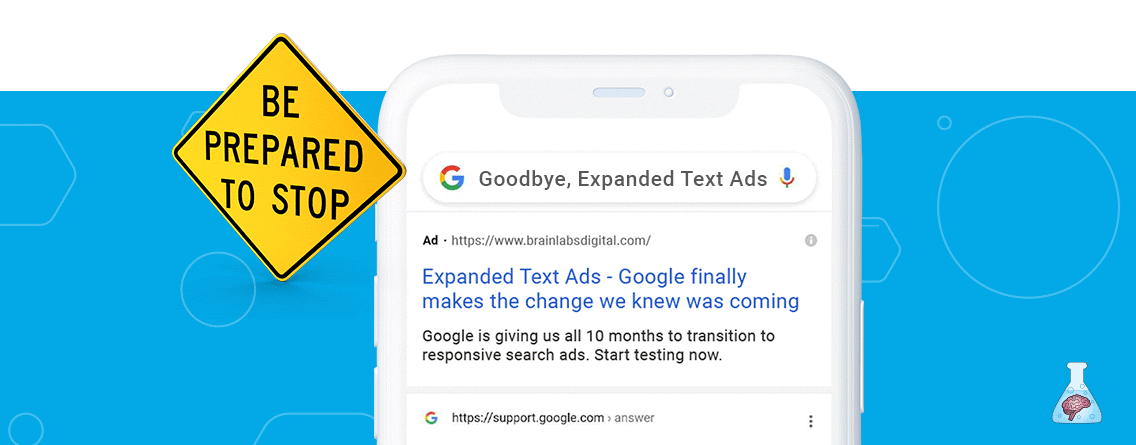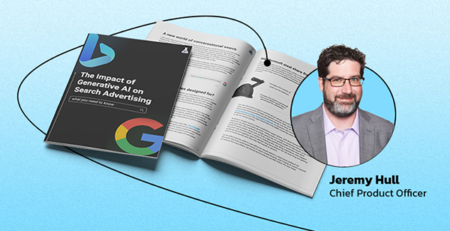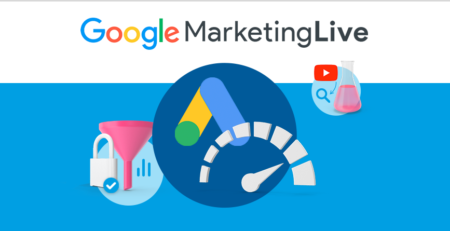Goodbye Expanded Text Ads: Google Announces Full Transition to RSAs
This week Google announced the change that every paid search marketer knew was coming sooner or later – the sunset of Expanded Text Ads (ETAs). With this change, Responsive Search Ads (RSAs) will become the core paid search text ad type for all advertisers.
If you haven’t started testing RSAs yet, don’t panic (but also–start testing RSAs. They work. Really well.). Google has generously given us ten months until this change goes live–plenty of time to deploy or refine your RSA strategy.
So let’s bid farewell to yet another Google ad format, and then take a look at the key things search marketers should keep in mind in order to create the most effective Responsive Search Ads.
A Look Back: The History of Expanded Text Ads
Launched in 2016, Expanded Text Ads provided approximately 50% more text than STAs (Standard Text Ads). Search marketers were able to utilize these additional character lengths to provide more details about their products to the searchers.
For historical context, STAs consisted of one 25-character headline and two 35-character description lines, whereas ETAs added a second headline and the expanded description line lengths to 80 characters. The second iteration of ETAs added a third description line and further increased the limit to 90 characters.
ETAs fully replaced STAs on January 31, 2017 (after a three month extension from original deadline of October 26, 2016).
Google has now announced that marketers will no longer be able to create or edit ETAs starting June 30th 2022. Based on similar past changes, we anticipate pre-existing ETAs will continue to serve for at least an additional year, although Google has not yet shared a definite date when they will be fully deprecated.
The new standard ad type: Responsive Search Ads
Responsive Search Ads debuted in 2018 and became the default ad format for text ads in February 2021. They enable advertisers to leverage Google’s automation and vast amounts of audience data to personalize messaging and rapidly test a massive amount of ad copy variations.
RSAs offer true query-time optimization by assembling the assets that are predicted to perform best for each individual user’s search based on contextual and intent signals. As an added bonus, RSAs can also show in more inventory across the Search Network and Partner sites, a clever incentive by Google to encourage advertisers to utilize this ad format. Google has found that overall, advertisers that switch from ETAs to RSAs (using the same assets) see 7% more conversions at a similar cost per conversion.
Instead of writing multiple discrete ads to test messaging, RSAs enable advertisers to submit up to 15 unique headlines and four description lines. Google then dynamically combines these assets to create tens of thousands of potential combinations. For brands who want or require more control over their messaging, Google offers the option to “pin” headlines and description lines in specific positions – for example, to ensure that a specific call to action always shows or to display legally required text (especially important for brands in regulated industries like finance and pharma).
One key benefit of RSAs is increasing the speed to optimization for search marketers. Advertisers save time by having Google do the testing. Prior to RSAs, an ad group may have had three to five ETAs running at a time with each testing a different message. Over time a winner will emerge, but determining that winner came at the expense of manual ad creation and the advertiser’s time. RSAs accelerate this process by enabling Google’s algorithm to do the testing rapidly and dynamically.
However, this functionality does come with a trade-off. For many search marketers, the frustration with RSAs has been the lack of transparency. As a whole, advertisers can see how each group of RSA assets performs – for example, in one test Brainlabs identified that an RSA produced 20 conversions at a cost per conversion that is half of its ETA counterpart. But Google does not yet provide insights into which assets and combinations are driving those conversions. Instead, Google only shows the number of impressions for each individual asset and combination. Even with all of the performance benefits that RSAs provide, some advertisers have continued to rely on ETAs to better see what messaging is working. We’re hopeful that over the next ten months Google will evolve and expand the reporting provided for RSAs to deliver more transparency that search marketers can utilize to derive insights based on specific combinations of ad assets.
How to Maximize Success with RSAs
If anything, the sunsetting of ETAs will simplify the ad creation process. By combining all available assets each RSA is able to generate upwards of 30,000 different combinations, so there’s no need to create multiple separate RSAs within the same ad group
Google’s recommended best practices for creating RSA assets is straightforward: Use the maximum number of available assets, make the assets distinct from one another, and include popular keywords in the headlines. The good news is that all of these factors can be evaluated via the Ad strength report in Google Ads. The better the ad strength, the better the projected performance.

Marketers should evaluate the importance of pinning ad assets. Pinning enables more control over the content of the displayed ads, but also reduces the number of permutations Google can deliver, so marketers that have historically pinned specific RSA elements should test whether removing these pins delivers incremental gains. Of course, as mentioned above brands in a restricted industry should continue to leverage pinned ad copy to ensure legal compliance.
One thing we have seen firsthand is that RSA performance dramatically improves when fueled with greater volumes of data through each ad group. A minimum of 3,000 impressions per week is the target amount recommended by Google’s Hagakure structure, and based on Brainlabs testing this does appear to hold true (and serves as the foundation of our own proprietary D’Artagnan structure). The removal of ETAs certainly puts more weight behind the argument to look at consolidating account structure, which also aligns well with other recent Google recommendations like making use of broad match keywords and leveraging smart bidding.
One big unknown off the back of this announcement is how Google will update their recommendations for overall creative best practices. Historically Google has recommended running at least 2 ETAs in each ad group alongside RSAs to allow the RSAs to learn from “static” ad formats. We’ll look forward to seeing how Google’s recommendations evolve in the near future as we test into our own updated Brainlabs best practices!
Unsurprising, but Still Actionable
This update didn’t come as a complete shock and will not disrupt current account performance – which is welcome news for retailers staring down a fast-approaching holiday season. Google has provided a long lead time before ETA creation is disabled, and RSAs are well established (have been around for well over two years).
Even if you haven’t yet deployed RSAs, the most important things to do next are:
- Review high-performing expanded text ads and identify top performers to inform RSA strategy
- If relevant, work with your/your client’s legal team to define which headlines need to be pinned down to meet compliance
- Test, test, test! The more ad variations you have, the more learnings you can gather.
As with any Google announcement, it is important to keep an open, curious mind. Know that this update should be an improvement directionally. Be curious about how it will impact performance and how you can test for optimal use cases – like pinning headlines for exact match keywords and testing different combinations for broad match.
Google is constantly evolving their product offerings, and these changes often bring new challenges. But in this case, we can confidently say that the best move is to lean into RSAs, which have proven to be an extremely effective ad format.




